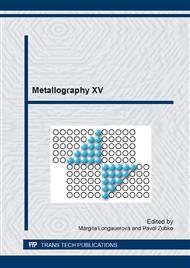p.215
p.221
p.227
p.231
p.235
p.239
p.243
p.247
p.251
Star Cracks in Continuously Cast Deep-Drawing Tin Steel Slab
Abstract:
The final quality of flat products is directly related to surface and internal quality of continuously cast slabs. This aspect is very important especially in case of IF and deep-drawing tin grades, in which even the smallest defects can cause problem in the final processing of the material, especially during forming by stamping, when the material fails. This work is devoted to the analysis of the surface defect of star crack type. The presence of defect was visually detected after scarfing process during removal of surface layer on the small radius side of the slab. This type of defect occurs particularly in cases, when steel is contaminated by copper in the process of continuous slab casting. In view of the copper melting point (1083°C) and the surface temperature of the cast slab shell at the mold exit (about 1200°C) in the process of steel cooling at continuous casting, Cu penetrates along the boundaries of primary austenitic grain, or separate particles are precipitated at the grain boundaries. Initial cracks are formed in the area of primary cooling in the mold. Thermal and mechanical stresses acting in the surface area of slab shell when the slab passes thorough the rollers of secondary cooling cause gradual expansion of crack defects along boundaries of grains contaminated by copper.
Info:
Periodical:
Pages:
235-238
Citation:
Online since:
April 2014
Authors:
Keywords:
Price:
Сopyright:
© 2014 Trans Tech Publications Ltd. All Rights Reserved
Share:
Citation:


